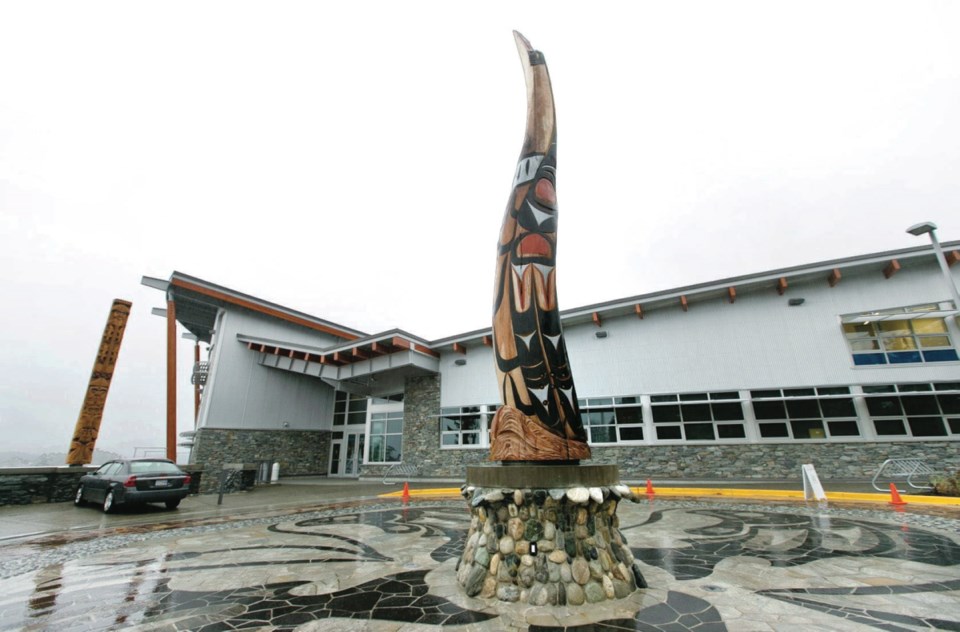Five huge wood carvings, richly detailed with imagery, stand tall in a wide arc high on the hillside. In the pattering rain we looked past them, across the foreshore and longhouse, over the lagoon to where low clouds wove among the hills beyond. The carver of the posts, Clarence Dick, held us enthralled with stories of these lands in the distant past, their glorious present and a future full of hope. This is Lekwungen.
Lekwungen: the place where the herring fish are smoked. It’s not far away. In fact, it is the place where we live, ranging from what is now called Cadboro Bay to Metchosin. For more than 3,000 years it has been the bountiful homeland of the Songhees Nation of the Coast Salish people. When the Hudson’s Bay men set up their fort in the Inner Harbour, the Songhees played host at an international campsite on the future site of Ocean Pointe Resort. In 1910, the Songhees people agreed to move their camp to the shorelands next to the navy base overlooking Esquimalt Lagoon. I had never been to the Songhees reservation before I accepted the invitation from Clarence Dick and his father, Butch Dick, to meet at the new Songhees Wellness Centre.
The reservation is private property and so is much of Salish culture. The elders decide how much can be made public and after a dark night of oppression, the Songhees are coming back to health and pride. At this time of transition, they are opening their hearts and legends to those of us who have colonized their home. This wellness centre and the complex story-telling house-posts that stand before it are a brilliant symbol of this new optimism.
We began inside, in the elegant gift shop, where artist Butch Dick, education liaison for the Wellness Centre, spoke of building bridges. For many years, Dick has worked with local school boards and on this occasion he was introduced by Gail Price-Douglas, who oversaw the installation of poles by Dick and his son Clarence in Victoria’s Centennial Square. They were here to welcome the Community Association of Oak Bay and the Rotary Club of Oak Bay, who are sponsoring Sno’uyutth (prounounced sno-wy-uth), a six-metre-tall pole they will be carving in front of the new Oak Bay High School. In the Songhees language Sno’uyutth means “spreading good energy.”
Designed by Victoria architect Philip Chang, the Wellness Centre is a sweeping, three-storey building that overlooks the lands and waters from a hillside above Esquimalt Harbour. Inside, its soaring atrium is backed by carved houseposts that frame a glass wall shaped like a native lodge. The centre’s boardroom is within, richly hung with Salish weavings and a remarkable chandelier. Everywhere, the centre is enriched with imagery: a thunderbird and whale inlaid in the linoleum; on the walls, giant spindle whorls; and prints and paintings contributed by well-wishers at the time of the building’s opening in January.
Like any government headquarters, there is a receptionist who is all efficiency. The director, elected chief Ron Sam, popped in and out between phone calls and meetings. The Songhees Nation deals with land and real estate here; RCMP and police have liaison offices; and upstairs, health clinics, exercise rooms and gathering points for the elders are provided. On the ground floor, education and social spaces for young people of the community are part of the layout. Beyond these “in-house” functions, the building is designed as a conference centre where as many as 300 people can meet in memorable surroundings. There is a fully functioning institutional kitchen and also a training kitchen where Songhees people can develop valuable skills.
The circular driveway is paved with local stone, inlaid in a whorl-pattern representing salmon and kelp. Rising in the centre from a still fountain of stones is a huge loon, carved from a tree 650 years old and more than two metres in diameter. The loon takes the form of a gigantic ladle, symbolic of the hospitality visitors will find here. On the parapet nearby, beyond which you see the waters and hills of the Lekwungen, stand four carvings, each six metres tall.
Clarence Dick led us outside to see his poles. These are not really “totem poles” and they are larger than the traditional house posts that held up the great beams in Salish lodges. These are a modern evolution of all those things, dense with stories carved in Dick’s unique style, which draws from the past and is growing with every new project. The carvings are setting precedents for future generations of artists, adding new and distinctive touches.
“I want to leave a legacy,” Clarence Dick explained. “I want my grandchildren to see them and say, ‘My granddad carved that.’ They’ll be here for 60 years if they take care of them.”
Esquimalt Harbour may seem a long way from Oak Bay, but it’s actually part of the same land. Not so long ago, coho salmon spawned in Bowker Creek and the Lekwungen people ranged over the Garry oak meadows, hunting and gathering food. The carving for Oak Bay High School will be a sign of reconciliation and respect, rich with local symbolism. At the top an Earth Mother will clutch two loons to her breast. Salmon and sea otters rise up through a field of camas, over a broad-mouthed frog at the base.
“It gets more exciting as more people join in the circle,” Butch Dick said to us. “To create awareness about cultures and building bridges is really all my educational teaching has been about. It’s so important to us as a people that we open ourselves up to learn about each other. And the best way to do this is to create something together.” Art will provide us all with this opportunity.
The Songhees Wellness Centre is located at 1100 Admirals Rd. (250-386-1043). For information regarding the Sno’uyutth pole, contact the Community Association of Oak Bay (caob.ca).
